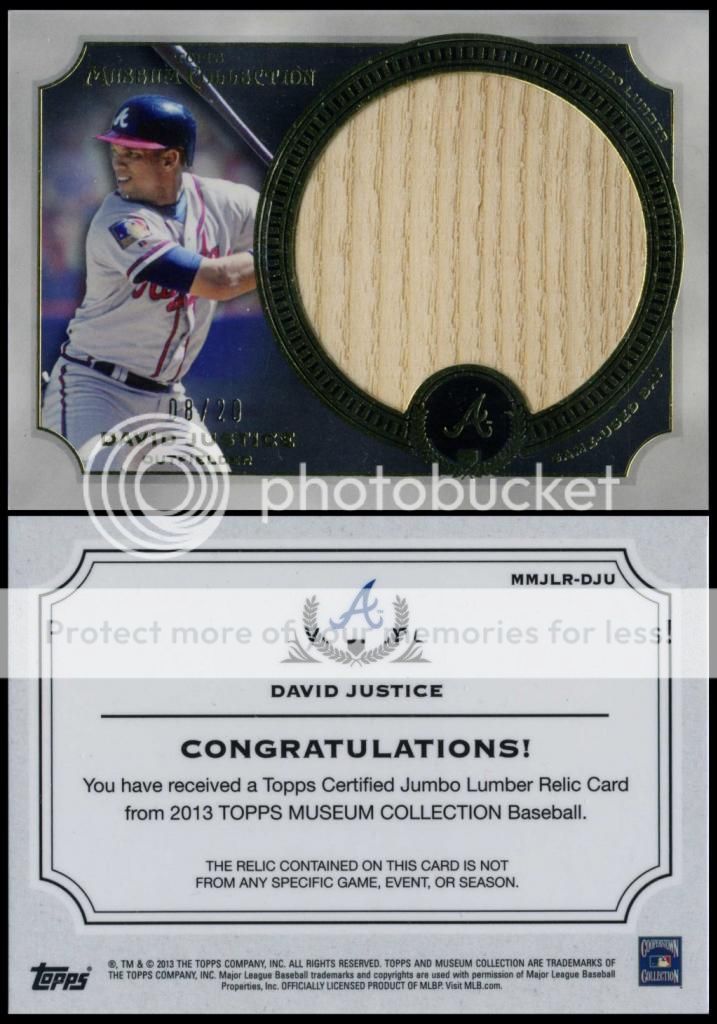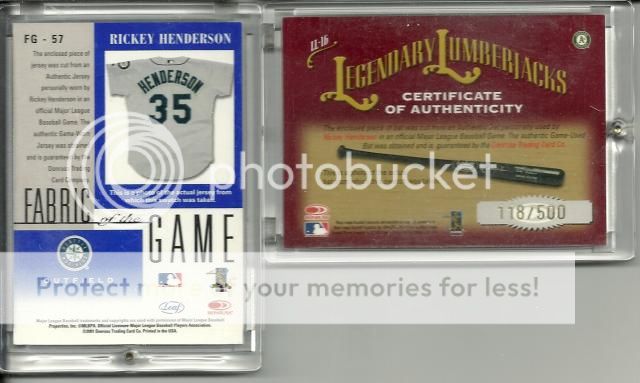CamaroDMD
Insert Cool Title
So, similar to this thread I posted a while back...I had wanted to get some opinions on a card I picked up a while back: https://www.sportscardclub.com/threads/what-is-game-used-coming-to.428601/
I really like this card, it is a 2013 Topps Museum Collection Jumbo Lumber Gold David Justice (8/20). As a kid, I was a huge David Justice fan...I remember fondly watching him hit the 1995 World Series Game 6 home run that clinched the series. To this day, he is one of my all time favorites.
When I first saw this card, I knew I wanted it. I have long questioned the GU authenticity on cards...but I still love how they look sometimes. However...I want your opinion as to "how game used" this piece really is. Here is what the card says:
Front: "Game-Used Bat"
Back: "The relic contained on this card is not from any specific game, event, or season."
Based on what I read on the card...I come to 3 possible conclusions as to how used the piece really is:
1. It was game used by David Justice in an official MLB game (be it spring training, regular season or post season during his career which spanned 1989-2002 and 4 teams).
2. It was game used by some player (could be anyone) in an official MLB game (be it spring training, regular season, or post season).
3. It was game used by some player at some level of baseball (be it MLB, minor leagues, college, semi-pro, or sandlot).
I'd like to believe that it falls under #1. But, the card doesn't say anywhere on it that it was actually used by Justice. It certainly hints at it...but doesn't say it for sure. I'm going to believe that it was...since he played for a long time there should be plenty of bats out there. But, I can't help but wonder if it falls under #2...or even (possibly) #3.
I'm curious what you think...how "game used" do you think this piece is?

I really like this card, it is a 2013 Topps Museum Collection Jumbo Lumber Gold David Justice (8/20). As a kid, I was a huge David Justice fan...I remember fondly watching him hit the 1995 World Series Game 6 home run that clinched the series. To this day, he is one of my all time favorites.
When I first saw this card, I knew I wanted it. I have long questioned the GU authenticity on cards...but I still love how they look sometimes. However...I want your opinion as to "how game used" this piece really is. Here is what the card says:
Front: "Game-Used Bat"
Back: "The relic contained on this card is not from any specific game, event, or season."
Based on what I read on the card...I come to 3 possible conclusions as to how used the piece really is:
1. It was game used by David Justice in an official MLB game (be it spring training, regular season or post season during his career which spanned 1989-2002 and 4 teams).
2. It was game used by some player (could be anyone) in an official MLB game (be it spring training, regular season, or post season).
3. It was game used by some player at some level of baseball (be it MLB, minor leagues, college, semi-pro, or sandlot).
I'd like to believe that it falls under #1. But, the card doesn't say anywhere on it that it was actually used by Justice. It certainly hints at it...but doesn't say it for sure. I'm going to believe that it was...since he played for a long time there should be plenty of bats out there. But, I can't help but wonder if it falls under #2...or even (possibly) #3.
I'm curious what you think...how "game used" do you think this piece is?

Last edited:

